
Imagine stepping into the year 2024, a world where software development is no longer a linear, rigid process but a dynamic, ever-evolving journey. In this fast-paced digital landscape, the traditional waterfall approach has given way to a more nimble and responsive paradigm – the realm of Agile Frameworks.
As we stand on the precipice of this future, it’s evident that the principles and practices of Agile will continue to shape the way we approach software development, enabling teams to navigate the complexities of an increasingly interconnected and rapidly changing world. But what does the future of Agile hold? How will these frameworks evolve to keep pace with the breakneck speed of technological advancements and shifting customer demands?
In this comprehensive guide, we’ll embark on a journey through the year 2024, exploring the cutting-edge trends, best practices, and innovative approaches that will define the future of Agile Frameworks. From leveraging data-driven insights to embracing emerging technologies, we’ll uncover the secrets to future-proofing your development processes and staying ahead of the curve in an ever-changing digital landscape.
The Rise of Data-Driven Agile
In 2024, data will be the lifeblood of Agile Frameworks, driving informed decision-making and enabling teams to adapt and evolve with unprecedented agility. The integration of advanced analytics and data visualization tools will empower organizations to gain deep insights into their development processes, enabling them to identify bottlenecks, optimize workflows, and make data-driven adjustments on the fly.
Imagine a world where every sprint, every user story, every line of code generates a wealth of data that can be harnessed to continuously improve and refine your Agile practices. Real-time dashboards and predictive models will provide teams with a holistic view of their development efforts, allowing them to anticipate potential roadblocks, allocate resources effectively, and ensure that every iteration delivers maximum value to end-users.
In this data-driven Agile landscape, teams will leverage advanced analytics to:
- Optimize sprint planning and resource allocation based on historical data and predictive models.
- Identify and address bottlenecks in real-time, enabling rapid course corrections and minimizing delays.
- Analyze user feedback and usage patterns to prioritize features and align development efforts with customer needs.
- Continuously monitor and refine development processes, fostering a culture of continuous improvement and adaptation.
By embracing data-driven Agile frameworks, organizations will unlock a new level of transparency, accountability, and agility, enabling them to navigate the complexities of software development with precision and confidence.
The Convergence of Agile and Emerging Technologies
As we move deeper into 2024, the lines between Agile Frameworks and emerging technologies will blur, giving rise to a symbiotic relationship that will redefine the boundaries of software development. Cutting-edge technologies such as artificial intelligence (AI), machine learning (ML), and the Internet of Things (IoT) will become integral components of Agile practices, enabling teams to automate routine tasks, enhance decision-making, and deliver truly innovative solutions.
Imagine leveraging AI and ML algorithms to analyze user stories, identify potential dependencies, and suggest optimal sprint configurations. Envision IoT-enabled development environments, where real-time data from connected devices and sensors inform and guide the development process, enabling teams to respond dynamically to changing conditions and customer needs.
In this converged landscape, Agile Frameworks will seamlessly integrate with:
- AI and ML-powered tools for requirements analysis, test automation, and code optimization.
- IoT-enabled development environments, facilitating real-time monitoring and continuous feedback loops.
- Augmented and virtual reality technologies for collaborative design, prototyping, and user testing.
- Blockchain and distributed ledger technologies for secure and transparent project management and code versioning.
By embracing the convergence of Agile and emerging technologies, teams will unlock new realms of innovation, efficiency, and adaptability, enabling them to deliver cutting-edge software solutions that push the boundaries of what’s possible.
The Rise of Distributed and Remote Agile Teams
As the world becomes increasingly interconnected and globalized, the traditional notion of co-located Agile teams will evolve, giving rise to a new era of distributed and remote Agile collaboration. In 2024, organizations will leverage advanced communication and collaboration tools to seamlessly integrate remote team members, fostering a culture of inclusivity and enabling access to a truly global talent pool.
Imagine a world where Agile teams span multiple time zones, cultures, and geographical locations, yet function as a cohesive unit, leveraging cutting-edge video conferencing, real-time document sharing, and virtual whiteboards to facilitate seamless collaboration and communication.
In this distributed Agile landscape, teams will:
- Leverage cloud-based project management and collaboration tools to ensure transparency and alignment across remote teams.
- Implement virtual stand-ups, retrospectives, and planning sessions, fostering a sense of community and inclusivity.
- Embrace asynchronous communication methodologies, enabling team members to contribute and collaborate across different time zones.
- Utilize advanced translation and localization tools to bridge language barriers and foster effective cross-cultural collaboration.
By embracing the rise of distributed and remote Agile teams, organizations will unlock a wealth of diverse perspectives, expertise, and talent, enabling them to deliver truly global software solutions that resonate with audiences worldwide.
The Evolution of Agile Methodologies
As we look towards 2024, it’s clear that the Agile landscape will continue to evolve, giving rise to new methodologies and hybrid approaches that cater to the unique needs of organizations and projects. While frameworks such as Scrum, Kanban, and Lean will remain foundational, we’ll witness the emergence of innovative hybrid methodologies that blend the best practices of multiple approaches.
Imagine a world where Agile teams leverage the principles of Design Thinking to foster user-centric development, while incorporating elements of DevOps to enable seamless collaboration between development and operations teams. Envision a future where organizations tailor their Agile practices to align with specific industry verticals, such as Agile for Finance, Agile for Healthcare, or Agile for Cybersecurity.
In this ever-evolving Agile landscape, teams will:
- Adopt hybrid methodologies that blend the strengths of various Agile frameworks, tailored to their specific project requirements and organizational culture.
- Embrace a modular and composable approach to Agile, enabling teams to mix and match practices from different methodologies to create a customized and optimized workflow.
- Continuously evaluate and refine their Agile practices, fostering a culture of experimentation and innovation that keeps pace with the ever-changing landscape of software development.
By embracing the evolution of Agile methodologies, organizations will future-proof their development processes, ensuring that they remain nimble, adaptable, and aligned with the latest industry best practices and emerging trends.
The Rise of Agile for Non-Software Domains
As we venture deeper into 2024, the principles and practices of Agile Frameworks will transcend the boundaries of software development, permeating into diverse domains and industries. From product design and manufacturing to marketing and business operations, the value of Agile methodologies will become increasingly recognized and adopted.
Imagine a world where Agile principles guide the development of physical products, enabling cross-functional teams to rapidly prototype, iterate, and incorporate customer feedback throughout the design and manufacturing process. Envision marketing teams leveraging Agile practices to rapidly adapt campaigns, respond to market trends, and deliver personalized, data-driven experiences.
In this era of Agile for non-software domains, organizations will:
- Adopt Agile methodologies for product design and development, fostering collaboration between engineering, design, and manufacturing teams.
- Leverage Agile practices in marketing and advertising, enabling rapid campaign iterations, real-time optimization, and data-driven decision making.
- Implement Agile frameworks in business operations, streamlining processes, enhancing cross-functional collaboration, and fostering a culture of continuous improvement.
- Explore the application of Agile principles in domains such as education, healthcare, and government, driving innovation and adaptability across diverse sectors.
By embracing the rise of Agile for non-software domains, organizations will unlock a new level of agility, innovation, and customer-centricity, enabling them to thrive in an increasingly complex and rapidly changing business landscape.
The Emergence of Agile Centers of Excellence
As Agile Frameworks become increasingly ingrained in organizational culture and processes, we’ll witness the emergence of Agile Centers of Excellence (ACEs) – dedicated teams or departments focused on promoting, enabling, and sustaining Agile.As Agile Centers of Excellence (ACEs) take root, they will play a pivotal role in driving the adoption, standardization, and continuous improvement of Agile practices across the organization. These dedicated teams will:
- Develop and maintain comprehensive Agile frameworks, tailored to the organization’s unique needs and industry requirements.
- Provide training, coaching, and mentorship to teams and individuals, fostering a deeper understanding and effective implementation of Agile principles.
- Establish governance and compliance processes to ensure adherence to Agile best practices and alignment with organizational goals.
- Facilitate knowledge sharing, collaboration, and the dissemination of lessons learned across Agile teams and projects.
- Continuously research and explore emerging trends, tools, and methodologies in the Agile ecosystem, ensuring the organization stays ahead of the curve.
- By nurturing Agile Centers of Excellence, organizations will cultivate a sustainable and scalable Agile culture, enabling them to consistently deliver high-quality software solutions while fostering a mindset of continuous improvement and adaptation.
Conclusion
As we stand on the precipice of 2024, it’s clear that the future of software development lies in the embrace of Agile Frameworks. From data-driven decision-making and the convergence with emerging technologies, to the rise of distributed teams and the evolution of methodologies, the Agile landscape is poised for a transformative shift.
Businesses that proactively adapt and future-proof their Agile practices will gain a competitive edge, enabling them to navigate the complexities of an ever-changing digital landscape with agility, innovation, and customer-centricity.
Companies like Upcore Technologies are at the forefront of this Agile revolution, providing cutting-edge solutions, expertise, and guidance to help organizations seamlessly integrate and leverage the power of Agile Frameworks. By partnering with industry leaders and staying ahead of the curve, businesses can future-proof their development processes, delight customers with exceptional software experiences, and maintain a competitive edge in an ever-evolving digital world.
Remember, the journey towards Agile excellence is a continuous pursuit, requiring a mindset of continuous learning, adaptation, and a willingness to embrace change. Embrace the principles outlined in this guide, foster a culture of Agile innovation, and embark on a transformative path that will propel your development efforts to new heights, enabling you to deliver truly remarkable software solutions that captivate customers and drive business success.


